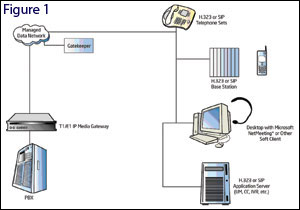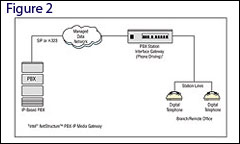|
Executives are understandably loath to swap out a fully functional phone system for a relatively unproven VoIP-based enterprise voice solution, even if they are aware that the newer technology might result in tremendous cost savings and increased employee productivity and business process efficiency.
It seems that they want VoIP for all the promises the technology offers, but are afraid of ripping out and completely replacing their legacy PBXs. Well, the good news is that they can deploy VoIP in a piecemeal fashion, eschewing the complete soup-to-nuts scrapping of their current investments.
There are any number of reasons to consider going slowly when it comes to deploying VoIP. Choosing to upgrade telecommunications systems in a measured fashion - division by division - allows IT personnel to maintain control during the transition period. Any problems that pop up in early phases of deployment can be worked out before migrating the next group of users. A slow approach also ensures that the new technology works in tandem with the existing legacy equipment, minimizing the impact of phasing out technology that employees are used to.
Of course a key element of any phased migration entails using a gateway to bridge between the old and the new. These so-called appliance gateways or media gateways need to transcode between legacy standards and next-generation standards such as SIP and H.323, thus enabling communication between traditional public switched telephone networks (PSTN) and IP-based networks. These gateways need to be easy to install and maintain. And they need to scale as the needs of the enterprise grow.
Media gateways allow enterprises to maintain their investment in their PBX systems as well as the expensive handsets deployed on each worker's desk, while at the same time opening up a world of innovative IP-based applications for increased productivity. The end result is a mixed telecom environment that allows users to take advantage of the latest applications and services while protecting the enterprise's existing investment in infrastructure.
Intel NetStructure Media Gateways
The Intel NetStructure PBX-IP media gateway is designed to allow a phased migration to IP, making it a good choice for enterprises not yet ready or willing to completely abandon their investment in legacy PBX equipment.
The gateway sits between the PBX or a digital handset and a LAN, WAN, or managed packet network, and converts digital PBX signals into a format suitable for transmission over standard IP networks.
Each gateway unit contains eight digital PBX or digital station interfaces and a 10/100 BaseT Ethernet connection for connecting to a LAN. An analog loop start unit designed for voice mail and unified messaging applications is also available to connect to PBXs that do not have an appropriate digital interface. The analog loop start unit supports several serial protocols for integrating IP applications to PBXs that support the SMDI, MCI, or MD110 protocols.
The gateway is an Intel building block that provides a simple, cost-effective transition to voice and data convergence for enterprises with PBXs. Connected externally, it offers an IP solution that works with current legacy equipment. It supports H.323 or SIP-based applications with fax running on network servers, remote terminals, or other devices as well as RTP/RTCP for delivery of voice over the LAN or WAN. The solution furthermore supports a variety of compression algorithms, including G.711, G.723.1, and G.729AB.
Intel is also moving one step deeper into the core network with their Intel NetStructure T1/E1-IP Media Gateway. The solution offers a "plug-and-play" approach and is geared toward service providers who want to upgrade their next-generation offerings without completely overhauling their equipment. The gateway is designed to enable offerings like hosted IP PBX services, IP Centrex, and enhanced messaging servers. It also offers support for supplementary services on the CAS, NI-2 and QSIG protocols, enabling functions like call transfer and forwarding, call waiting, and caller ID without any additional programming required. The gateway is a good fit for enterprises interested in deploying applications like remote office connectivity, PBX extensions, call centers, long-distance consolidation and IP media servers.
As media gateway functionality moves deeper into the core of the IP network, service providers are free to roll out a variety of enhanced multimedia services while adding IP support to their networks at a rate that is comfortable to them. By eliminating the need for large-scale equipment upgrades, service providers can continue to support legacy phones, PBXs, and services while quickly rolling out IP-based functionality. This makes core-based IP media gateways a valuable stepping stone for any carrier interested in migrating to IP in a timely and cost effective manner. IT
Greg Galitzine is editorial director of Internet Telephony magazine.
Laura Stotler writes about IP Communications and related topics for TMCnet.
SAMPLE DEPLOYMENTS
The Intel NetStructure PBX-IP Media Gateway and T1-E1 IP Media Gateway can be used to connect IP telephones to a legacy PBX, integrate network-hosted applications with the PBX, extend the PBX to branch offices, and integrate various voice, fax, and call processing capabilities in an enterprise LAN or WAN environment.
These media gateways can function in several scenarios:
Scenario 1 Emulates digital station sets to a digital PBX. This mode uses H.323 or SIP standards to interface with H.323 or SIP devices, such as IP phones or softphones, on the IP-based network at a main site or a home office.
Scenario 2 Connects remote offices to a main-office PBX over a managed packet network. Basically, the gateway extends PBX functionality to digital phones at a remote site.
Scenario 3 Drives proprietary digital station sets from an IP device, such as an IP-PBX or IP-server.
Scenario 1: Adding IP at a Corporate Office
The media gateway appliances from Intel can be used to connect H.323 or SIP phones, softphones,  or H.323 or SIP applications servers to the corporate PBX (Figure 1). or H.323 or SIP applications servers to the corporate PBX (Figure 1).
In this example, using the Intel NetStructure T1-E1 IP Media Gateway to supply a link between a legacy PBX and new IP technology can supply the following benefits:
Provides a low-cost way to add IP technology to an existing legacy system.
Protects investment in legacy equipment.
Prevents disruption of service.
Reduces development costs.
The type of system enabled with this gateway is very different from a toll bypass gateway setup. To create a toll bypass configuration, gateways are placed at two different sites, and the corporate WAN carries calls between the two sites to avoid the PSTN and consequent toll charges.
The Intel NetStructure T1-E1 IP Media Gateway has quite a different function. It is an IP-enablement tool that allows IP technology to be introduced easily and gradually into a legacy environment at the pace that the enterprise finds most cost-effective for its workload and current infrastructure.
Scenario 2: Connecting Legacy Phones to an IP-PBX
Just as IP phones can be used with a circuit-switched PBX because of media gateways, legacy phone sets can be used with an IP-PBX with the Intel NetStructure PBX-IP media gateway (Figure 2).

Scenario 2 is very common in market segments such as retail. Retailers often have digital phones installed throughout their stores, but need to migrate to an IP-PBX for new applications to remain competitive. The PBX-IP Media Gateway allows retailers to install an IP-PBX, but continue to use their legacy phones without rewiring each of their stores. However, all types of organizations can use the PBX-IP media gateway if they wish to install an IP-based PBX and want to preserve their investment in legacy phone equipment.
Scenario 1 is an example of an emulating media gateway. Scenario 2 is an example of a different model called a phone-driving unit.
Scenario 3: Deploying Converged Multimedia IP Services Throughout the Enterprise
 The Intel NetStructure T1-E1 IP Media Gateway along with Intel NetStructure Host Media Processing Software supports the development of cost-effective IP media servers accessible from both PSTN and IP networks. IP media servers can provide a central and efficient messaging server in existing TDM voice infrastructures by servicing remote locations via an IP network. The Intel NetStructure T1-E1 IP Media Gateway along with Intel NetStructure Host Media Processing Software supports the development of cost-effective IP media servers accessible from both PSTN and IP networks. IP media servers can provide a central and efficient messaging server in existing TDM voice infrastructures by servicing remote locations via an IP network.
In this scenario (Figure 3), both the T1-E1 IP Media Gateway and the PBX IP Media Gateway are used to deploy multimedia applications in the headquarters location and to remote offices around the world.
|

